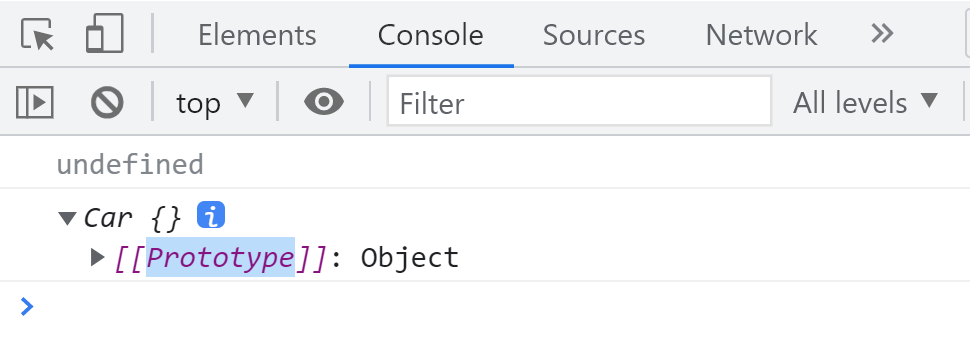原型与作用域深入解析
原型
原型 prototype 是 function 对象的一个属性,同时 prototype 本身也是一个对象。
function Handphone() {
// prototype
}
console.log(Handphone.prototype);

prototype 定义了构造函数创建的每个对象的公共祖先。
以下示例中,hp1.rom 和 hp2.ram 都可以访问到原型上的属性。所有通过该构造函数创建的对象,都可以继承原型上的属性和方法。
function Handphone(color, brand) {
this.color = color;
this.brand = brand;
this.screen = '4:3';
this.system = 'Android';
}
Handphone.prototype.rom = '64G';
Handphone.prototype.ram = '6G';
var hp1 = new Handphone('red', 'Xiaomi');
var hp2 = new Handphone('black', 'Huawei');
console.log(hp1.rom);
console.log(hp2.ram);
原型上的属性和对象上的属性
访问对象上的属性时,如果不存在,会继续查找原型上的属性。
function Handphone(color, brand) {
this.color = color;
this.brand = brand;
this.screen = '4:3';
this.system = 'Android';
}
Handphone.prototype.rom = '64G';
Handphone.prototype.ram = '6G';
Handphone.prototype.screen = '16:9';
var hp1 = new Handphone('red', 'Xiaomi');
var hp2 = new Handphone('black', 'Huawei');
console.log(hp1.screen);
console.log(hp2.rom);
处理冗余和耦合
在上述示例中,每次 new 时,Handphone 函数内部都会重复赋值 screen、ram 和 rom,这导致代码冗余和耦合。
为减少冗余,可以将 screen 和 system 挂载到原型上。
需要传参的属性写在构造函数内部,固定不变的属性写在原型上,通过继承 prototype 来共享。
通常,JavaScript 中的方法挂载到原型上,因为方法不常变更。属性则需要根据需要在构造函数中传递。
function Handphone(color, brand) {
this.color = color;
this.brand = brand;
}
Handphone.prototype.rom = '64G';
Handphone.prototype.ram = '6G';
Handphone.prototype.screen = '4:3';
Handphone.prototype.system = 'Android';
var hp1 = new Handphone('red', 'Xiaomi');
var hp2 = new Handphone('black', 'Huawei');
console.log(hp1.screen);
console.log(hp2.screen);
function Handphone(color, brand) {
this.color = color;
this.brand = brand;
}
Handphone.prototype.rom = '64G';
Handphone.prototype.ram = '6G';
Handphone.prototype.screen = '4:3';
Handphone.prototype.system = 'Android';
Handphone.prototype.call = function () {
console.log('I am calling someone');
};
var hp1 = new Handphone('red', 'Xiaomi');
var hp2 = new Handphone('black', 'Huawei');
hp1.call();
hp2.call();
开发时建议的写法
建议将原型定义为一个对象,以便更清晰地管理属性和方法。
function Handphone(color, brand) {
this.color = color;
this.brand = brand;
}
Handphone.prototype = {
rom: '64G',
ram: '6G',
screen: '4:3',
system: 'Android',
call: function () {
console.log('I am calling someone');
},
};
var hp1 = new Handphone('red', 'Xiaomi');
var hp2 = new Handphone('black', 'Huawei');
hp1.call();
hp2.call();
对原型的增删改
通过实例化的对象,无法直接对原型进行增删改。
function Test() {}
Test.prototype.name = 'prototype';
var test = new Test();
console.log(Test.prototype);
test.num = 1;
delete test.name;
test.name = 'proto';
console.log(Test.prototype, test);
function Handphone(color, brand, system) {
this.color = color;
this.brand = brand;
this.system = system;
}
Handphone.prototype = {
rom: '64G',
ram: '6G',
screen: '4:3',
call: function () {
console.log('I am calling someone');
},
};
var hp1 = new Handphone('black', 'iPhone', 'iOS');
console.log(hp1);
console.log(hp1.constructor);

Constructor
构造器 constructor 指向构造函数本身。也就是说,构造函数通过 constructor 创建对象。
function Handphone(color, brand, system) {
this.color = color;
this.brand = brand;
this.system = system;
}
var hp1 = new Handphone('black', 'iPhone', 'iOS');
console.log(Handphone.prototype);

修改指定的构造函数
function Telephone() {}
function Handphone(color, brand, system) {
this.color = color;
this.brand = brand;
this.system = system;
}
Handphone.prototype = {
constructor: Telephone,
};
var hp1 = new Handphone('black', 'iPhone', 'iOS');
console.log(Handphone.prototype);

Prototype
实例化后,每个对象都有一个原型 Prototype,它属于实例对象,而非构造函数本身。
function Car() {}
Car.prototype.name = 'Benz';
var car = new Car();
console.log(car);

当 this 没有 name 属性时,会继续查找实例对象的原型 __proto__,如果原型中存在 name,则打印该值。
function Car() {}
Car.prototype.name = 'Benz';
var car = new Car();
console.log(car.name);
__proto__ 可以被改动
__proto__ 是每个实例对象的原型的引用容器,用于指向 prototype。虽然可以修改 __proto__,但不建议轻易改动。
function Person() {}
Person.prototype.name = '张三';
var p1 = {
name: '李四',
};
var person = new Person();
console.log(person.name);
person.__proto__ = p1;
console.log(person.name);
对属性的重写
在 JavaScript 中,建议使用单引号以避免与后端产生冲突,有时需要转义。
function Car() {}
Car.prototype.name = 'Mazda';
var car = new Car();
Car.prototype.name = 'Benz';
console.log(car.name);
实例化前后
实例化后重写 prototype
Car.prototype.name = 'Benz';
function Car() {}
var car = new Car();
Car.prototype = {
name: 'Mazda',
};
console.log(car.name);
实例化前重写 prototype
Car.prototype.name = 'Benz';
function Car() {}
Car.prototype = {
name: 'Mazda',
};
var car = new Car();
console.log(car.name);
Window 和 Return
window.a 相当于将 a 置于全局作用域。
function abc() {
window.a = 3;
}
abc();
console.log(a);
window 和 return 都可以形成闭包
// 使用 return
function test1() {
var a = 1;
function plus1() {
a++;
console.log(a);
}
return plus1;
}
var plus = test1();
plus();
plus();
plus();
// 使用 window
function test2() {
var a = 1;
function add() {
a++;
console.log(a);
}
window.add = add;
}
test2();
add();
add();
add();
window 和 return 的区别
window.变量 将函数放到了全局作用域,而 return 函数 则将函数赋值给了一个变量,如果未被接收,函数会被自动回收。
// 使用 return 的立即执行函数
var add = (function () {
var a = 1;
function add() {
a++;
console.log(a);
}
return add;
})();
add();
add();
add();
// 使用 window 的立即执行函数
(function () {
var a = 1;
function add() {
a++;
console.log(a);
}
window.add = add;
})();
add();
add();
add();
JS 插件的写法
通过立即执行函数隔离作用域,防止变量污染。
(function () {
function Test() {}
window.Test = Test;
})();
var test = new Test();
在前面添加引号是约定俗成,防止忘记添加 ;,确保立即执行函数正常执行,并能快速识别立即执行函数。
(function () {
var Component = function () {};
})();
练习
构造函数接收数字类型的参数,完成数字相加和相乘的功能
function Compute() {
var result = 0;
this.plus = function () {
result = 0;
result = loop(arguments, 'add', result);
};
this.times = function () {
result = 1;
result = loop(arguments, 'mul', result);
};
function loop(args, method, res) {
for (var i = 0; i < args.length; i++) {
var item = args[i];
if (method === 'add') {
res += item;
} else if (method === 'mul') {
res *= item;
}
}
console.log(res);
return res;
}
}
var compute = new Compute();
compute.plus(1, 2, 3); // 输出 6
compute.times(1, 2, 4); // 输出 8